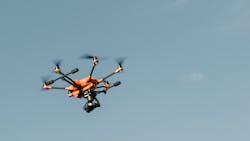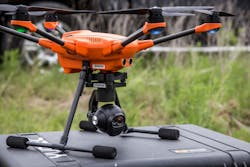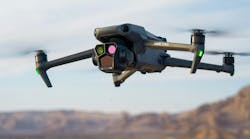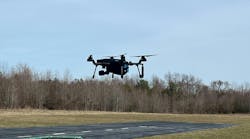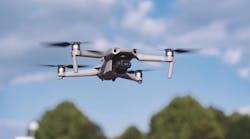The potential of systems are on “trial” around the country. For example, the New York Police Department has announced they would begin utilizing a 14-drone program to provide its law enforcement officers a bit of early situational awareness. As NYPD Chief of Department Terence Monahan stated in a December press briefing, “Growing technology will give cops and their incident commanders an opportunity to see what they are getting into before they go into harms way.” NYPD’s unmanned aerial vehicle (UAV) program was done under collaboration with Florida-based FLYMOTION. The Oro Valley (Ariz.) Police Department demonstrated the Fuse Tether System by Drone Aviation Corp., which powers certain models of drones to fly for extended periods of time via a powered cord. In a third example, the Chula Vista (Calif.) Police Department has seen further success in their experimental program having run 231 missions with 14 arrests.
A walk on the floor of any high-tech tradeshow will provide more examples of law enforcement’s use of sUAS. Two of which include InterDrone 2019 which runs Sept. 3 to 6, in Las Vegas (www.interdrone.com) and the Commercial UAV Expo Oct. 28 to 30, Las Vegas (www.expouav.com). There’s also the chance you’ll see more in shows like PSE or the NSA Expo. Any of these will provide you aisles of opportunities to upgrade your toolbox with the ability of flight.
One of these such tools is the Yuneec (pronounced “unique”) H520. Out of the box, this UAV jumps out at you and itches to get itself up into the sky. Intuition is the theme here, one that runs through every of the H520’s nooks and crannies. Yuneec set MSRP from $1,999 to $4,699, depending on model.
Depending on the flight plan and use of payload, Yuneec reports the H520 to have a 25 to 28 minute flight time. Set up correctly with the DataPilot software, the system will calculate where the UAV will automatically land for a fresh battery to continue the mission. With a one-mile range, any other modern high-tech company would have dubbed this a “smart” drone.
The platform allows a good number of camera payloads—also easily swappable if you have the need for multiple cameras. The original three cameras were the E90 with a 20 MB one-inch sensor that’s capable of taking high-quality 4K resolution video at 60 frames per second; the E50 is a 39mm 4K video camera allowing you to operate farther away from your objective; and the CGOET thermal imaging and 1080p low-light camera features an innovative 3-axis gimbal for stability.
Installation of camera payloads follows the intuitive feeling of sliding in the battery. There’s a sturdy clip on the mounting bracket which comes already attached by three hex-socket screws. All you have to do is slide the camera to snap. No wires. No additional batteries.
While the drone may get the attention, for me the star of the show is the ST16S controller. This is the workhorse of the entire system. The device allows an officer to control the drone’s flight, the camera, as well as plot out a flight plan. Whether it was my incoordination or lack of skill, there is a short learning curve maneuvering the H520 while adjusting the camera view. Keep that in mind. Try it out and keep the “OBS Avoid” function on. This allows the system to automatically detect objects 8 to 10 feet away with the onboard forward-facing sonar system.
The drone itself is quick in the air with a max speed of 43 mph on high and a low around 25 to 27 mph. Since the cold has an effect on the batteries, while it can fly in sub-freezing temperatures you will see a slight decrease in air time. Yuneec explained that the H520 has an IMU built-into the flight control board which warms up the battery before the flight in colder temperatures. On the other end of the thermometer, the H520 should be able to fly up to 110 to 115 degrees F and hover stable against 35 mph winds.
One interesting feature is the ability to have dual controllers for a single H520. This clever solution would allow one pilot to keep their eye on the sUAS, the other controlling the camera. The advantages of this are self-evident, but it’s not the only trick the device has up its sleeve. For me, the DataPilot software is where this system shines.
Using the 7-inch touchscreen, an officer can set up and launch a full flight plan by plotting out waypoints or via the system’s survey tool. Maps can be downloaded via Bing, Google, Statkart, Eniro or Esri. Once you have an idea of what exactly you want your drone to do, all you need to do is set up the specifications correctly and launch. As stated in their release, “DataPilot, which is tightly coupled to the PX4 flight control architecture, was developed in conjunction with Lorenz Meier, head of Advanced R&D, who was recognized as an honoree of MIT Technology Review’s 2017 Innovators Under 35 list.” Be warned. This software controls a lot, so know exactly what you want to do. From general settings for the controller itself, you can set the system up to manage speed, tilt, angles, program specific places to take photographs/video, and a whole lot more.
There is a ton of potential and capability under the hood of the Yuneec H520. With careful preparation and skillful training, this will definitely elevate your agency’s toolbox to new heights. If you’re interested in checking one out yourself, Yuneec does offer a loan program to test it out for a month. Agencies are welcome to purchase directly from the company or through distributors.
